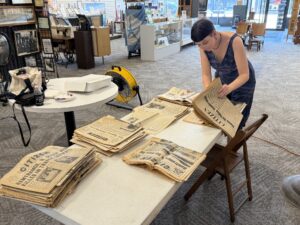Read all news(papers), at the Hamtramck Historical Museum

The Hamtramck Historical Museum has been busy cataloguing its collection of newspapers. Photo Hamtramck Historical Museum
By Alan Madlane
The Hamtramck Historical Museum recently began devoting a portion of its time to organizing its newsprint collection.
We were fortunate to be able to get together with museum board member Sam Burns, and have him fill us in on how this project is coming along, and other aspects of it.
The Review: What papers are you collecting ?
Sam Burns: The museum collects any items, including newspapers that are relevant to the history of the City, Village, or Township of Hamtramck.
Most of the newspapers in our collectionare local papers, primarily the Citizen, the Hamtramck Times, and the Hamtramck Review, but we also have a nice variety of short-lived or small-circulation papers.
We also collect individual issues of non-Hamtramck papers that include content on Hamtramck.These are mostly from local publications like the Detroit News, the Detroit Free Press, or the Oakland Press, but include some from further afield and in languages other than English.
The Review: Why reorganize the newspaper collection?
Burns: The reorganization of our newspaper collection is part of a comprehensive project to catalog and curate all the collections and archives that we own.
We began to receive donated items back when we were astart-up institution with no permanent home or budget, and the collectionquickly outgrew our infrastructure.
As we’ve been able to make significant improvements to our building and equipment, we’ve placed a high priority on bringing our collections and archives management up to professional standards.
We are currently in the first phase of the project, which involvesidentifying everything in our collection, organizing it all into proper storage containers, and noting any items that will need specialist care.
The Review: How far back do the various collections go? Are they complete?
Burns: We’re still in the process of identifying everything in our newspaper collection, so I can only speak generally, but the bulk of our papers date from the 1970s through the 1990s. A few of our individual papers date back to the late 1800s.
As far as we know, none of our series are complete, but we might end up being surprised! We have several full boxes, and a whole series of bound volumes, of the Citizen, and a substantial collection of the Hamtramck Review and the Hamtramck Times.
The Review: Any plans to digitize the collection, or has that already been done, or started?
Burns: We’ve recently invested in a Digitization Station, which should be up and running by the end of the summer.
We plan to train some volunteers on how to use it and immediately start digitizing a sample of individual articles that are relevant to other museum initiatives, such as our History Day activities with local students or our Deep Mapping project (https://mappinghamtramck.com/).
In the long term, we plan to systematically digitize the entire collection, but that will take an enormous investment of time and money.
The Review: Newsprint is notoriously easily ruined – by sunlight, handling, moisture, mildew and any other of a variety of age- and use-related problems. How do you deal with these issues?
Burns: Most of our newspapers have been stored in clean file boxes or file cabinets, so they’ve been protected from the worst sources of deterioration. However, these are not long-term storage solutions, and the older papers in our collection are starting to show their age.
In the current phase of our comprehensive project, volunteers have been placing groups of newspapers into archival quality polyester sleeves and then into acid-free newspaper storage boxes.
These items are not cheap, but we’ve been able to lean on our community support, as well as a few grants, and have purchased enough supplies to “triage” the newspaper collection.
Eventually, we plan to purchase enough museum-quality supplies to store each individual paper in its own polyester sleeve, and to create custom enclosures for especially fragile items.
Once we have the entire collection triaged, we’ll be able to figure out how much this will cost, and then set some fundraising goals.
The Review: Do you allow the public to check the newspapers out, like a library might (although most do not), or use them only in-house, or not be touched at all and only used digitally?
Burns: Generally, our collections do not leave our building except under a formal loan agreement with a qualified institution.
However, while some items may be too fragile or rare for public access, we’re happy to make as much of our collections as possible available to anyone who wishes to use them within the building.
Email samuelburns@hamtramckhistory.com to set up a research appointment.
The Review: Are you looking for any collections to add that you don’t yet have?
Burns: We accept donations that meet our collections criteria, which include most items that are associated with the history of the City, Village, and Township of Hamtramck.
Once we’ve finished cataloging the newspapers we already have, we’ll start a focused effort to fill any gaps in our collection.
The Review: Can you speak about the efforts your volunteers – where do they come from, and what exactly are they doing to help and under whose oversight?
Burns: One of our board members, David Figiel, has recently launched a formal volunteer program, which is open to anyone in the community at any level of experience.
Our volunteers are a diverse group that includes everyone from students to retirees, and from lifelong Hamtramckans to recent arrivals.
We have many different opportunities for volunteers to get involved, including staffing the front desk, conducting research for tours and exhibits, helping with community outreach, and assisting with our collections.
We hold monthly collections and archives drop-in sessions, with the next session scheduled for Sunday, August 24 from 1-3 p.m. at the museum.It is open to the public, no experience required, and walk-ins are welcome!
This month, we hope to finish organizing the newspapers. Once we’re finished with them, we’ll be moving on to other areas of the collection, so there will be on-going opportunities for the public to come and get hands-on experience with our historical items.
The Review: Please feel free to add anything else you would like to about your paper collection.
Burns: Anyone interested in learning more about volunteering at the museum can email David Figiel (davefigiel@gmail.com) or attend one of our drop-in sessions. We are always looking to expand our community of volunteers!
The museum is located at 9525 Jos. Campau at Norwalk. They are open to the public Fri.-Sun. 11 a.m.-3 p.m. (4 p.m. on Sat.) or by pre-arranged appointment only outside those times. Call (313) 262-6571.
Posted Oct. 25, 2025

